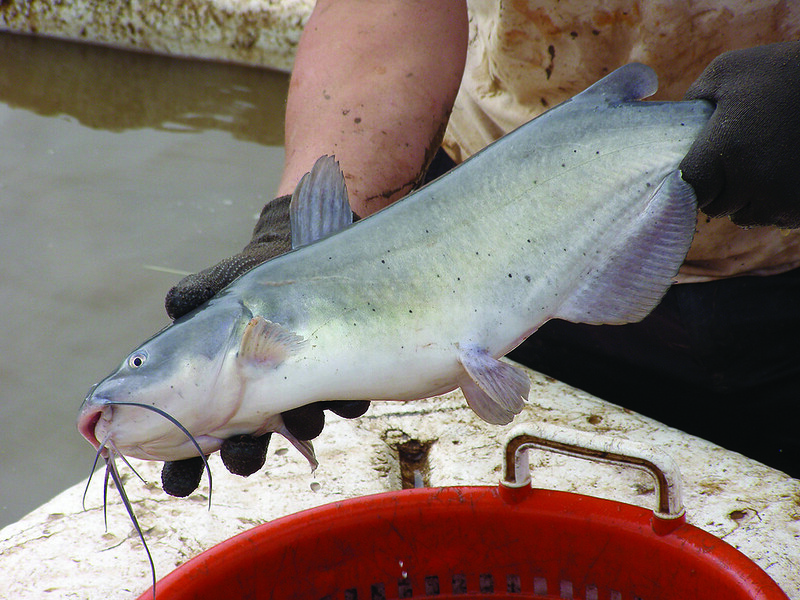By Mary Hightower
U of A System Division of Agriculture
Rising grain prices are draining Arkansas’ catfish industry.
Four states — Mississippi, Alabama, Texas and Arkansas — produce 97 percent of catfish sales in the United States. U.S. catfish sales were $371 million during 2020, down 2 percent from $380 million the previous year.
Last year, U.S. farm-raised catfish production was 324 million pounds from 59,305 acres of water. Arkansas produced 15.7 million of those pounds from 3,900 acres, valued at $16.6 million.
Arkansas is No. 3 behind Mississippi and Alabama in foodsize inventory as of July 1, according to the National Agricultural Statistics Service, part of the U.S. Department of Agriculture. “Foodsize” is defined as fish that are 0.75 to heavier than three pounds. The same report showed Arkansas had 9.5 million stocker fish, up 2 percent from a year ago.
Declining pond acreage
In 2002, Arkansas had 37,500 acres of ponds in catfish production.
“By 2021, the industry is one-tenth that size, at just 3,700 acres,” said Scott Stiles, extension economist for the University of Arkansas System Division of Agriculture.
“One reason for the decline can be attributed to a sharp increase in feed prices that ran from 2007 to 2013,” he said. “From 2007 to 2013 the state’s catfish industry lost 22,200 water acres: a decline of 73 percent.”
Stiles said that catfish feed prices are largely driven by grain prices. What the catfish industry refers to as “32 percent feed” typically contains 30 to 44 percent soybean meal and 15 to 20 percent corn.
“Feed costs represent approximately 50 percent of total operating costs for catfish farmers,” he said.
“The U.S. average price for soybean meal rose 160 percent from $189 per ton in 2006 to a peak of $490 per ton in 2013,” Stiles said. “Over the same period, average corn prices in the U.S. moved to record highs, peaking at $6.89 per bushel in 2012.”
And the grain market news was only getting worse for catfish growers.
“For 2021, average soybean meal prices are projected to be the highest since 2013 at $395 per ton,” he said. “When feed costs are at high levels, growers may switch to a 28 percent feed to reduce costs. However, that option is still expensive as growers report paying $482 per ton in the past week for floating feed.”
If there is a bright spot for producers, it’s fish prices.
“Fortunately, catfish prices are slightly better than last year’s average of $1.06 per pound,” Stiles said. “Current farm-level prices are in the range of $1.25 to $1.30 per pound.”
Continued uncertainty
With August being a key yield-determining month for U.S. soybeans, some continued price volatility can be expected.
“Catfish producers are encouraged to keep an eye on the corn and soybean futures markets,” Stiles said. “With U.S. corn and soybean inventories at multi-year lows, there is potential for significant price volatility for the remainder of 2021 and into 2022. Catfish producers might consider booking a portion of their feed needs on pullbacks in grain prices.”
To learn about extension programs in Arkansas, contact your local Cooperative Extension Service agent or visit www.uaex.uada.edu. Follow us on Twitter and Instagram at @AR_Extension. To learn more about Division of Agriculture research, visit the Arkansas Agricultural Experiment Station website: aaes.uada.edu. Follow on Twitter at @ArkAgResearch. To learn more about the Division of Agriculture, visit https://uada.edu/. Follow us on Twitter at @AgInArk.
About the Division of Agriculture
The University of Arkansas System Division of Agriculture’s mission is to strengthen agriculture, communities, and families by connecting trusted research to the adoption of best practices. Through the Agricultural Experiment Station and the Cooperative Extension Service, the Division of Agriculture conducts research and extension work within the nation’s historic land grant education system.
The Division of Agriculture is one of 20 entities within the University of Arkansas System. It has offices in all 75 counties in Arkansas and faculty on five system campuses.
\The University of Arkansas System Division of Agriculture offers all its Extension and Research programs and services without regard to race, color, sex, gender identity, sexual orientation, national origin, religion, age, disability, marital or veteran status, genetic information, or any other legally protected status, and is an Affirmative Action/Equal Opportunity Employer.






